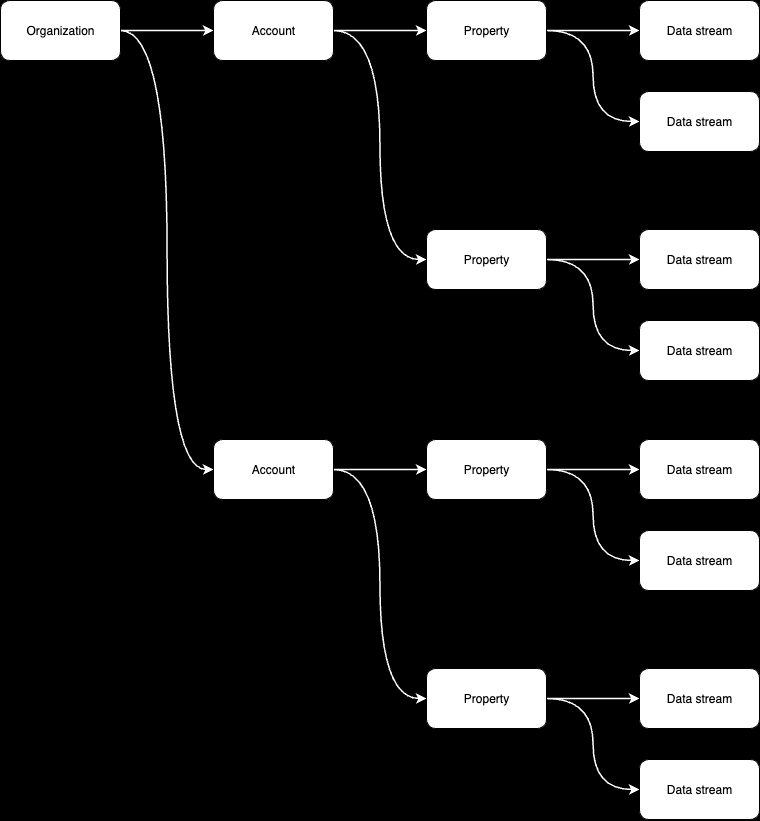GA4 Account Hierarchy: A Field Guide
The right decisions about your GA4 account structure can mean the difference between seamless reporting and absolute chaos
If there’s one decision that can make or break your Google Analytics 4 (GA4) setup, it’s how to structure your accounts and properties.
We consult businesses large and small on all things tagging and analytics, and I’ve seen almost every mistake that can be made on projects where we’ve been called in to help after other agencies had left a mess.
I won’t bore you with the details, but I will say that without a well-thought-out design, your GA4 setup can get ugly fast. It’s why I always recommend starting at the drawing board and playing out different scenarios until you come to the setup that’s just right for your organization’s needs.
To draw those scenarios out and make those decisions, you need to know the GA4 account hierarchy—in other words, the Lego blocks given to you by Google when setting up the world’s most popular analytics tool.
Whether you’re about to set up GA4 for the first time or are dealing with an existing setup in bad need of a reorganization, I’ve written this guide to help.
Let’s dive in.
Google Analytics 4 Account Hierarchy

- Organizations in Google Marketing Platform contain Google Analytics 4 (GA4) accounts
- GA4 accounts contain GA4 properties where the data is collected
- GA4 properties contain GA4 data streams that collect data
Google Marketing Platform organization
What it is: Organizations in Google Marketing Platform represent your company for user group management and billing purposes.
How it relates to other structures: An organization in Google Marketing Platform can contain GA4 accounts. (Each account must explicitly be linked to the organization for that to be true.)
Limits to know about: A single user who has the role of Organization admin or User admin can create up to 100 organizations. This limit is practically impossible to hit unless you work at an agency with many clients (though it would frankly be difficult to do so even then).
What else to know:
The Google Marketing Platform organization is typically the name of your company. It’s like a cockpit that lets you manage user groups and permissions for your accounts and properties from one central place. It’s also where you handle billing if your organization uses Google Analytics 360, the paid version of Google Analytics.
In rare cases, holding companies with highly independent subsidiaries à la Berkshire Hathaway may require more than one Google Marketing Platform organization to be set up. But most companies need only one organization—and centralized orchestration is rare in holding companies this big, since most subsidiaries tend to have their own agencies and setups.
Technically, this is an entirely optional step. You could skip creating a Google Marketing Platform organization and start setting up your accounts and properties instead.
However, I strongly advise against skipping this step. It’s just bound to cause headaches for you in the future—it’s better to start with an organization and link your GA4 accounts to it from the get-go; it’s a decision that will pay dividends in the long term.
We were called in by a company that didn’t have a Google Marketing Platform organization. The symptom: user access management for their Google products had become slow and incredibly expensive.
We created one, then had to trace the owners of all GA4 accounts and ensure that their accounts were properly linked to it. It took weeks of detective work, but the setup was finally brought back into central control. Administering the GA4 accounts suddenly became cheaper and faster.
GA4 account
What it is: GA4 accounts organize your GA4 properties.
How it relates to other structures: A GA4 account can be linked to a Google Marketing Platform organization. An account can have one or more properties.
Limits to know about: There are no limits to how many accounts can be linked to an organization, at least not limits that Google has publicly disclosed.
What else to know:
The purpose of an account is to simplify user access management to the properties that it contains. It’s purely organizational. Rather than having to give users access to the properties one by one, you can assign them access to all properties under one account.
The general rule when structuring a GA4 setup is to group similar properties under the same account. Exactly how to apply this rule depends on the use case.
For example, a startup with one product may choose to have one GA4 account with two GA4 properties: one property for its website and another for its SaaS application.
In contrast, a Fortune 500 company with a portfolio of 20 brands may choose to either have as many GA4 accounts with one property each or to organize its properties under fewer accounts that represent its business units.
There is no single recommendation for how to approach structuring your properties. In my experience, what tends to work best is to get the right people in a room and play out the different options until you come to the option that, to the best of your knowledge at the time, makes the most sense.
Provided you get the setup generally right, you can always do housekeeping and adjust this or that later. The mistake would be to not think about that setup from the beginning at all, as large-scale account-structure flaws can be costly to fix.
GA4 property
What it is: GA4 properties are where event and user data from websites and mobile apps is collected via data streams.
How it relates to other structures: A GA4 property is created within a GA4 account. To create a property, you must first create an account.
Limits to know about: You can create up to 2,000 properties in one account.
What else to know:
A useful way to think about GA4 properties, then, is as containers that house your data. When setting up Google Analytics 4, you can create as many properties as necessary to organize that data.
Some of the main things that you can do within a GA4 property are to create audiences and segments, define custom dimensions and key events, analyze results in reports and explorations, and decide how long to retain the collected data in Google’s cloud.
If your organization uses Google Analytics 360, then you can also create two special types of properties: subproperties and roll-up properties.
These two types of properties don’t collect data on their own. Instead, they help you separate (subproperties) or aggregate (roll-up properties) the data from your existing properties to make it easier to activate and report on at scale.
To learn more about them, check out our guide to GA4 subproperties and roll-up properties.
GA4 data stream
What it is: GA4 data streams collect data from websites or mobile apps within the GA4 properties that they are part of.
How it relates to other structures: Data streams are created within properties. To create a data stream, you first need to create a property.
Limits to know about: You can create up to 50 data streams in one property, and only 30 of those data streams can be for data flows from mobile apps (Android and iOS).
What else to know:
Data streams are meant to organize (and separate) the websites and mobile apps that send data to your Google Analytics 4 property.
There are three types of data streams: Web for websites, Android for the Android builds of mobile apps, and iOS for the iOS builds of mobile apps.
So, if you have a brand with a website and a mobile app that’s available on both Apple’s and Google’s operating systems and you decide to feed all data into a single property, you would effectively have three data streams in that property (one for the website, one for the Android app, and one for the iOS app).
But data streams can also separate the sections of a single website when that level of separation makes sense. For example, a client with a multi-national website in a dozen geographies decided to house their data in one property with a Web-type data stream for each.
Here too, there is no single approach to recommend for how many data streams you should have within a property. To make that decision, you should consider your digital presence and come to the structure that makes the most logical sense.
